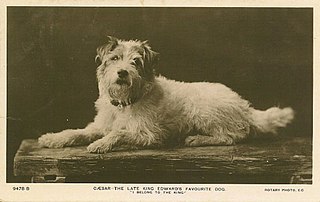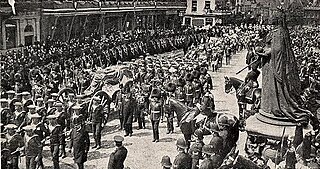 W
WEdward VII was King of the United Kingdom of Great Britain and Ireland and Emperor of India from 22 January 1901 until his death in 1910.
 W
WThe Edwardian era or Edwardian period of British history spanned the reign of King Edward VII, 1901 to 1910, and is sometimes extended to the start of the First World War. The death of Queen Victoria in January 1901 marked the end of the Victorian era. Her son and successor, Edward VII, was already the leader of a fashionable elite that set a style influenced by the art and fashions of continental Europe. Samuel Hynes described the Edwardian era as a "leisurely time when women wore picture hats and did not vote, when the rich were not ashamed to live conspicuously, and the sun really never set on the British flag."
 W
WAlexandra of Denmark was Queen consort of the United Kingdom and the British Dominions and Empress consort of India from 1901 to 1910 as the wife of King Edward VII.
 W
WThe Statue of Edward VII stands in Stanley Park, Bootle, Sefton, Merseyside, England. It was erected to commemorate the Coronation of King Edward VII and consists of a bronze statue of Edward VII on a granite pedestal. The sculptor was George Wade. The statue was given to the borough by the local Member of Parliament, and stands on land given to the borough by Lord Derby. It was unveiled by Lady Derby in 1904.
 W
WCaesar (1898–1914) was a Wire Fox Terrier owned by King Edward VII. He was bred in the kennels of Kathleen, Duchess of Newcastle, and became the constant companion of the King. After the King's death in 1910, the dog attended the funeral and walked in the procession in prominence ahead of nine kings and other heads of state. Caesar has been the subject of paintings, and a hand crafted hardstone model created by the House of Fabergé.
 W
WThe coronation of Edward VII and his wife Alexandra as king and queen of the United Kingdom and the British Dominions took place at Westminster Abbey, London, on 9 August 1902. Originally scheduled for 26 June of that year, the ceremony had been postponed at very short notice, because the King had been taken ill with an abdominal abscess that required immediate surgery.
 W
WThe Edward VII Monument is a statue of King Edward VII by artist Louis-Philippe Hébert and located at Phillips Square in Montreal, Quebec, Canada.
 W
WEduardo VII Park is a public park in Lisbon, Portugal. The park occupies an area of 26 hectares to the north of Avenida da Liberdade and Marquis of Pombal Square in Lisbon's city center.
 W
WThe two pence (2d) Tyrian plum was a postage and revenue stamp produced by Britain in 1910 as a replacement for the existing two colour 2d stamp of King Edward VII.
 W
WThe King Edward VII Memorial is a sculpture in memory of King Edward VII, located in Centenary Square, Birmingham, England.
 W
WThe funeral of Edward VII, King of the United Kingdom of Great Britain and Ireland and emperor of India, occurred on Friday, 20 May 1910.
 W
WThe Hokitika Clock Tower, initially called the Westland War Memorial and then the Coronation and War Memorial, is a prominent landmark in Hokitika, New Zealand. The memorial was initiated, fundraised for, and carried out by a committee, to commemorate the region's contribution to the Second Boer War; not just the four local men who had died but all 130 who had gone to war in South Africa. An additional purpose was to provide Hokitika with a town clock.
 W
WA homburg is a semi-formal hat of fur felt, characterized by a single dent running down the centre of the crown, a wide silk grosgrain hatband ribbon, a flat brim shaped in a "pencil curl", and a ribbon-bound trim about the edge of the brim. It is traditionally offered in black or grey.
 W
WThe King Edward VII Coronation Medal was a commemorative medal issued in 1902 to celebrate the coronation of King Edward VII and Queen Alexandra.
 W
WThe King Edward VII Jewish Memorial Drinking Fountain is a drinking fountain on the Whitechapel Road in the East End of London.
 W
WThe Police Coronation Medal was sanctioned in 1902 as an award to policeman, firemen and members of ambulance units on duty during the official celebrations of the Coronation of King Edward VII and Queen Alexandra on 9 August 1902.
 W
WKing Edward VII's Town Coach is a carriage of the Royal Mews, Buckingham Palace. Not being a State Coach, it is much plainer than some of the other carriages kept at the Mews.
 W
WBaroness Olga de Meyer was a British-born artists' model, socialite, patron of the arts, writer, and fashion figure of the early 20th century. She was best known as the wife of photographer Adolph de Meyer and was rumoured to be the natural or god-daughter of King Edward VII of the United Kingdom. After 1916, she preferred to be known as "Mahrah de Meyer".
 W
WKing Edward VII was the monarch of the United Kingdom of Great Britain and Ireland and of the British Empire from 22 January 1901 until his death on 6 May 1910.
 W
WPrince Albert is an American brand of pipe tobacco, introduced by the R.J. Reynolds Tobacco Company in 1907. It has been owned since 1987 by John Middleton Inc.
 W
WThe royal baccarat scandal, also known as the Tranby Croft affair, was a British gambling scandal of the late 19th century involving the Prince of Wales—the future King Edward VII. The scandal started during a house party in September 1890, when Sir William Gordon-Cumming, a lieutenant colonel in the Scots Guards, was accused of cheating at baccarat.
 W
WThe Royal Victorian Order is an order of knighthood awarded by the sovereign of the United Kingdom and several Commonwealth realms. It is granted personally by the monarch and recognises personal service to the monarchy, the Royal Household, royal family members, and the organisation of important royal events. The order was officially created and instituted on 23 April 1896 by Letters Patent under the Great Seal of the Realm by Queen Victoria. It was instituted with five grades, the highest of which was Knight Grand Cross (GCVO), which conferred the status of knighthood on holders.
 W
WThe statue of Edward VII in Bangalore is located at Queen's Park, next to Cubbon Park, Bangalore Cantonment, at the junction of Queen's Road and Cubbon Road. The statue was unveiled on November 1919 by the then Viceroy and Governor-General of India, Frederic John Napier Baron Chelmsford. The statue was raised out of funds raised by the residents of the Bangalore Civil and Military Station. The Statue of King Edward VII is one of the few of the original statues which were installed in British India, to still stand at its original location. The statue rises above a flowering frangipani tree. On the other end of Queen's Park is the Statue of Queen Victoria, Bangalore The statue was designed and sculpted by Leonard Jennings of Chelsea, London.
 W
W